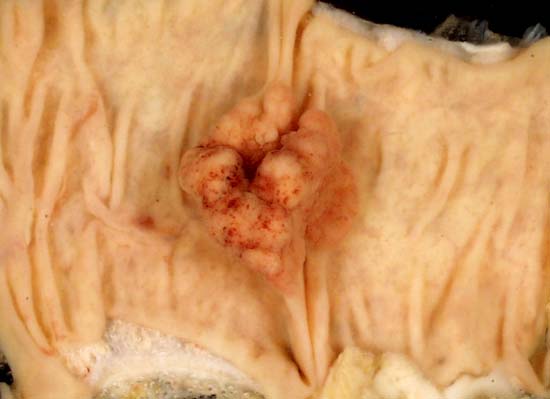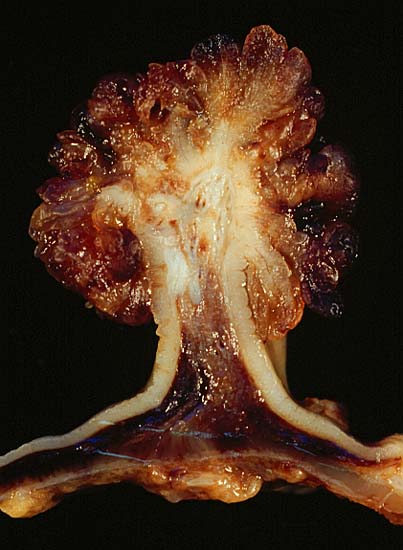Colon polyps
Editor-In-Chief: C. Michael Gibson, M.S., M.D. [1]
|
WikiDoc Resources for Colon polyps |
|
Articles |
|---|
|
Most recent articles on Colon polyps Most cited articles on Colon polyps |
|
Media |
|
Powerpoint slides on Colon polyps |
|
Evidence Based Medicine |
|
Clinical Trials |
|
Ongoing Trials on Colon polyps at Clinical Trials.gov Clinical Trials on Colon polyps at Google
|
|
Guidelines / Policies / Govt |
|
US National Guidelines Clearinghouse on Colon polyps
|
|
Books |
|
News |
|
Commentary |
|
Definitions |
|
Patient Resources / Community |
|
Patient resources on Colon polyps Discussion groups on Colon polyps Patient Handouts on Colon polyps Directions to Hospitals Treating Colon polyps Risk calculators and risk factors for Colon polyps
|
|
Healthcare Provider Resources |
|
Causes & Risk Factors for Colon polyps |
|
Continuing Medical Education (CME) |
|
International |
|
|
|
Business |
|
Experimental / Informatics |
Please Take Over This Page and Apply to be Editor-In-Chief for this topic: There can be one or more than one Editor-In-Chief. You may also apply to be an Associate Editor-In-Chief of one of the subtopics below. Please mail us [2] to indicate your interest in serving either as an Editor-In-Chief of the entire topic or as an Associate Editor-In-Chief for a subtopic. Please be sure to attach your CV and or biographical sketch.
Overview
A polyp can be defined as lining of mucosa which projects out in a mushroom shape. If they have a stalk they are called pendulated if there is no stalk present they are called sessile. They are commonly found in the colon.
A colonic polyp is a polyp found in the colon. They are mostly benign but have the potential to become malignant.
There are many causes which can be neatly broken down into categories.
Types
Neoplastic, Hamartomatous, inflammatory, metaplastic.
Neoplastic polyp
A neoplasm is a tissue whose cells have lost its normal differentiation. They can be either benign growths or malignant growths. The malignant growths can either have primary or secondary causes.
Neoplastic polyps of the bowel are often benign hence called adenomas. An adenoma is tumour of columnar cells or glandular tissue.
Neoplastic polyps can be further broken down into tubular, tubularvillous or villous. They are all broken down into these categories by histology.
The villous subdivision is the worse one to have because the have the most malignant potential. The reason for this is because the villous are projections into the lumen and hence has a bigger surface area and therefore they have a greater potential for malignant change.
Metaplastic polyp
Metaplasia is defined as when the cells of the epithelia change from one type to another like in Barrett’s oesophagus, where the cells change from squamous to columnar.
Metaplastic polyps are an overgrowth of tissue of normal mucosa. The name "metaplastic polyp" is actually a misnomer as there is no change in epithelia. Metaplastic polyps are the most common type of colonic polyp followed by adenoma polyps. But unlike adenomas they have no malignant potential and rarely grow larger than 5mm.
Hamartomatous polyp
They are growths, like tumours found in organs as a result of faulty development. They are normally made up of a mixture of tissues. They grow at the normal rate of the host tissue and rarely cause problems such as compression. A common example of a hamartomatous lesion is a strawberry naevus. Hamartomatous polyps are often found by chance; occurring in syndromes such as Peutz-Jegher or Juvenile Polyposis Syndrome.
Peutz-Jeghers syndrome is associated with polyps of the GI tract and also increased pigmentation around the lips, genitalia, buccal mucosa feet and hands. People are often diagnosed with Peutz-Jegher after presenting at around the age of 9 with an intussusception. The polyps themselves carry little malignant potential but because of potential coexisting adenomas there is a 15% chance of colonic malignancy.
Juvenile polyposis syndrome are polyps which often present when the patient is young hence called juvenile. Patients normally present young with rectal bleeding. Polyps can be solitary or multiple (>5). If there are multiple the condition is then referred to as Juvenile Polyposis. This condition may have a genetic association. Patients require upper and lower endoscopic screening with removal of polyps. If you fear adenomatous tissue developing then you can offer surgery, namely colectomy and ileorectal anastomosis
Inflammatory polyp
These are polyps which are associated with inflammatory conditions such as Ulcerative Colitis and Crohns disease.
When does a polyp become a problem?
Malignant potential is associated with
- degree of dysplasia
- Type of polyp (e.g. villous adenoma)
- Size of polyp:
- <1cm =<1 risk of cancer
- 1cm=10%risk of cancer
- 2cm=15%risk of cancer
Normally an adenoma which is greater than 0.5cm is treated
Presentation
Patients normally present with rectal bleeding. But can also present with cramp abdominal pain with altered bowel habits. With profuse bleeding you can present with Iron deficiency anaemia.
Treatment
Patients require flexible sigmoidoscopy or Colonoscopy to diagnose. Polyps can just be removed during these procedures. The patient will require regular screening via endoscopy to monitor progress of disease.
Severe disease can be treated with colonic resection.
External links
- http://www.netdoctor.co.uk/diseases/facts/colonpolyps.htm
- http://www.clevelandclinic.org/registries/inherited/jp.htm
Pathological Images
-
Adenomatous polyp of colon: This 2.5 cm adenomatous polyp was serendipitously found in a right colectomy specimen. The colon was removed to bypass an extrinsic obstruction caused by metastatic ovarian cancer. In the picture above, the long axis of the opened bowel is horizontal, and the mucosa is viewed en face.
-
Adenomatous polyp of colon: Longitudinal section of the same polyp
-
Tubulovillous polyp of the colon: The polyp viewed "down" from "above" its head, looking down toward the out-of-focus native mucosa from which it arises. This polyp is usually dark because of the bleeding into the mucosa and submucosa caused by the abortive attempts at endoscopic removal.
-
The polyp is shown in longitudinal section


